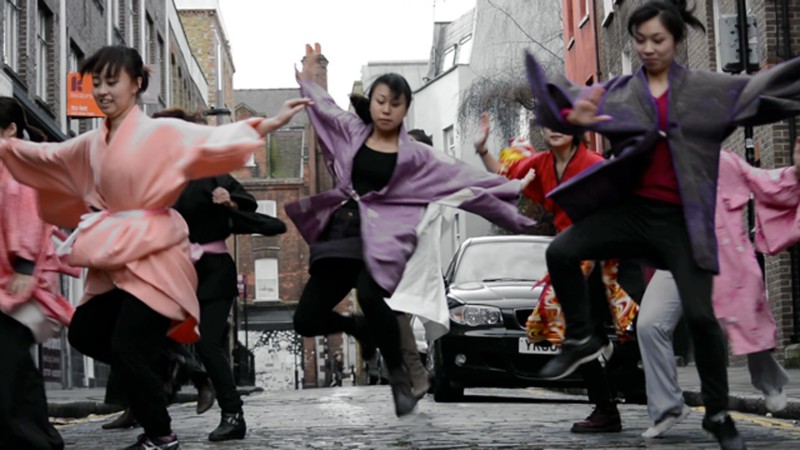 Okuni opens with a voice over explaining in clear level tones that Kabuki is the theatre and dance of the avant-garde or bizarre. Then we see a stern male figure in robes, flanked by two younger women: his face is chiselled and still, their faces are mobile and smiling. The stage is set for a clash between the traditional and the new, the old and the young. There is a story behind the dance and dialogue – of Okuni a female dancer who struggles to maintain her looks and fame in the face of her younger protégé who begins to mock her precise and studied traditional dance. The production is difficult to follow at times in terms of narrative, but the dance is virtuoso and carries a story with in it: when we see the young pupil dancing a fusion of Japanese dance and Bollywood it is a great visual joke as well as being a satisfying dance in its own right.
Okuni opens with a voice over explaining in clear level tones that Kabuki is the theatre and dance of the avant-garde or bizarre. Then we see a stern male figure in robes, flanked by two younger women: his face is chiselled and still, their faces are mobile and smiling. The stage is set for a clash between the traditional and the new, the old and the young. There is a story behind the dance and dialogue – of Okuni a female dancer who struggles to maintain her looks and fame in the face of her younger protégé who begins to mock her precise and studied traditional dance. The production is difficult to follow at times in terms of narrative, but the dance is virtuoso and carries a story with in it: when we see the young pupil dancing a fusion of Japanese dance and Bollywood it is a great visual joke as well as being a satisfying dance in its own right.
The theme of the new usurping the old is played out in the dance, and in the efforts of Okuni to remain young –she follows an American promotional video of how to stretch and exercise the face to keep the skin supple and young, and then a video of breast massage that she eagerly copies again. The principal dancer easily conveys a quiet desperation as well as a comic effect, as when she tries to imitate the new dances of the age like hip-hop. The performance is at its best when it stays in dance: the play within the play where the male dancer is made to play a female role has a very stilted dialogue. I wonder whether a lot has been lost in translation from the Japanese, which is able to pinpoint social and personal unease and differences in class much more subtly in its inflexions and honorifics. As it was the high falsetto voice of the male-turned-female dancer narrating the story of the play topples over into the ridiculous.
Laying this aside there are beautiful set pieces – the two younger dancers perform in different styles including stylised martial combat which is great to see. The show uses a lot of back projection, and in the middle there is a very beautiful sequence of dancing in a city street that has a joyful flowing quality. The production was a little marred though by the constant failure of the back projection and film to stop and start at the right times, leaving at one stage the principal dancer rather lost and bewildered on the stage in front of us. As a fusion of dance styles and a meditation in movement on the venerated and the new the performance has a lyrical touch, which becomes rather leaden once it descends into dialogue and plot. The dance and movement is strong enough on its own to carry the performance and perhaps a lot of the dialogue is not needed – the voiceover at the beginning and end is strong and confident and helps us locate the show in Japanese tradition: that kind of narration was more effective than the rather stilted dramatic speech on stage.
